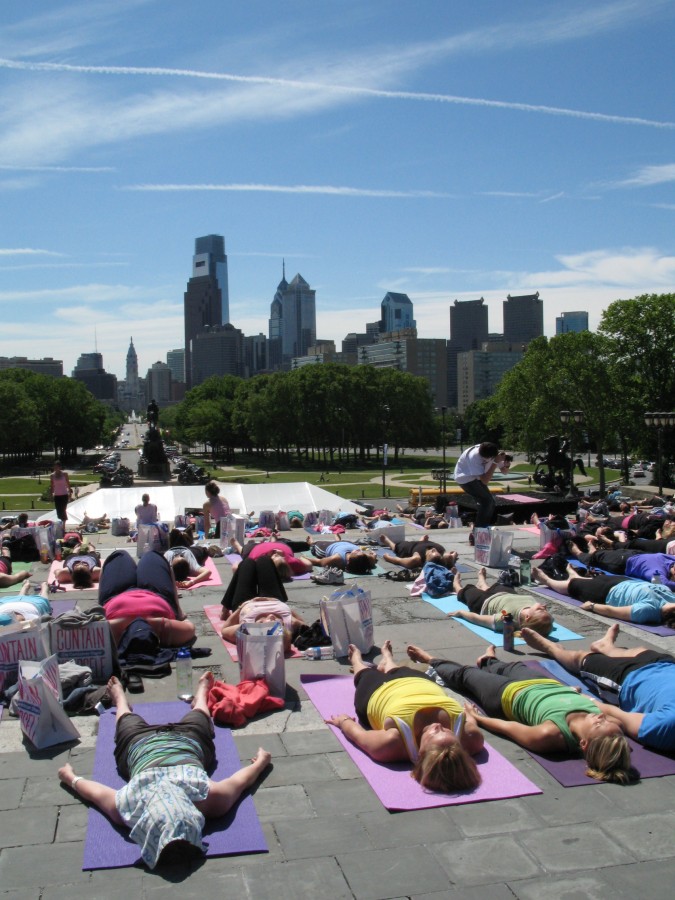Restorative yoga is one of the most underrated of all the kinds of yoga out there but one of the yummiest, the dessert of yoga. You won’t get Taylor Lautner’s abs from doing this kind of practice since there is no jumping and hopping around like some of the power yoga classes out there but they are gentle restorative yoga poses if you have cancer.
There are various adjustments to traditional yoga that allow for a gentle, therapeutic practice. This is called restorative yoga and classes generally consist of poses, breathing and meditation.
Yoga may also assist in managing depression, anxiety, insomnia, pain, and fatigue. It can increase the quality of life for those directly affected by cancer and those who care for them. Complementary therapy such as yoga can be crucial in helping those affected by cancer develop a solid physical, emotional and mental base as they make- the sometimes difficult- transition from being a person with cancer to living as a cancer survivor.
Cancer patients often find themselves in distracted states of mind—bombarded as they are by frightening, sometimes contradictory, information, subjected to invasive, painful procedures, and not-always-compassionate medical care. When our minds are so grievously disturbed, we may find it impossible to make crucial decisions or relate satisfactorily to our family and friends. Practicing controlled breathing exercises (also called Pranayama), meditation can help in relieving tension. When the tension is released, energy can flow more easily in the body and allow patients to experience a sense of well-being, emotional mastery and strength. In healthy people when practiced appropriately with an experienced teacher, yoga is generally considered to be safe especially restorative yoga poses for cancer.
People with certain medical conditions should not do certain yoga practices or should consult a medical practitioner that is also knowledgeable about yoga poses and contraindications. For example, people with disc disease of the spine, extremely high or low blood pressure, glaucoma, retinal detachment, fragile or atherosclerotic arteries, a risk of blood clots, ear problems, severe osteoporosis, or cervical spondylitis should avoid some inverted poses.
Although yoga during pregnancy is safe if practiced under expert guidance, pregnant women should avoid certain poses that may be problematic and should only practice with a teacher trained in prenatal yoga.
Yoga can boost a woman’s quality of life while she’s being treated for breast cancer. According to recent research, women who did yoga classes had better emotional, social, and spiritual well-being compared to women who didn’t do yoga. Women who were not having chemotherapy got more benefits from yoga. This could be because fatigue and other chemotherapy side effects may make it harder to participate in a yoga class.
Maintaining balance in your life while dealing with breast cancer can be difficult. Yoga focuses on the interactions between your mind, your body, and your behavior. While scientific research on yoga is relatively new and the studies are small, early results have shown that some yoga may help ease physical and emotional symptoms in some people. When combined with conventional medicine, complementary therapies may offer a more integrated approach to healing.
Sleep disturbances and fatigue are an enormously burdensome problem among cancer survivors; 30 to 50 percent of newly diagnosed or recently treated cancer patients have trouble sleeping, and 70 to 96 percent of recently treated cancer patients complain of fatigue. The reasons for this aren’t clear. Experts cite psychosocial factors as well as physical ones.
Restorative yoga, which is the most gentle kind of yoga, may provide some relief of fatigue and depression problems for women with breast cancer. In restorative yoga you can hold the poses for longer because you’re being supported. Researchers found women who practiced this gentler version of the popular mind-body therapy had a 50 percent reduction in depression and a 12 percent increase in feelings of peacefulness.
Practicing continuous flowing movements has a positive impact on the lymphatic system and in particular Lymphedema. When lymph fluid is disrupted through breast cancer surgery, trauma or infection there may be an excessive fluid build up. This stagnant fluid can play havoc on the tissues and create swelling. There also can be a reduction of the oxygen intake or absorption to the lymphatic system; all of which increases the chance for infection.
Practicing a flowing yoga keeps the lymphatic fluid pumping throughout the body’s channels, rather than accumulating or backing up. It is great for maintaining healthy breast tissue. To keep this fluid moving, we need to also foster relaxation. It will facilitate renewed or restored strength, and flexibility.
Flowing yoga movements develop a supple spine and a strong nervous system so when the nervous system is in balance the parasympathetic and sympathetic system work together creating great calm.
When flowing in the practice the poses encourage digestion, assimilation and elimination. The body’s immune system is stimulated to maintain health. When flowing from a backward bend to a forward bend, the spine will roll vertebra by vertebra, either in an ascending or descending order, while following the natural wave of the spine. Here it will recognize naturally that a backbend (extension) will flow from a forward bend (flexion) and vice versa.
There is so much to learn from survivors about being in a warrior pose. Living with fear helps make a warrior. It is the first lesson cancer teaches a survivor, being prepared for the uncertainty of their new life. Having worn the coat of a life-threatening diagnosis, practicing savasana is no longer just an “idea” or an abstraction, but can be an unavoidable part of daily life. I believe this is the biggest difference in teaching yoga to cancer survivors. A life-threatening illness can help us all learn how to live fearlessly. Another difference is that it can become a shared goal for both the yoga teacher and student. If faced directly, cancer is everyone’s teacher.
What are your thought about practicing yoga and when you have cancer?

